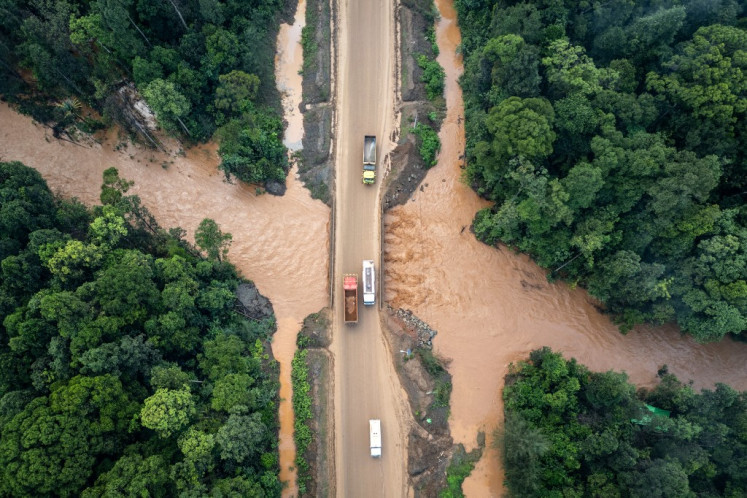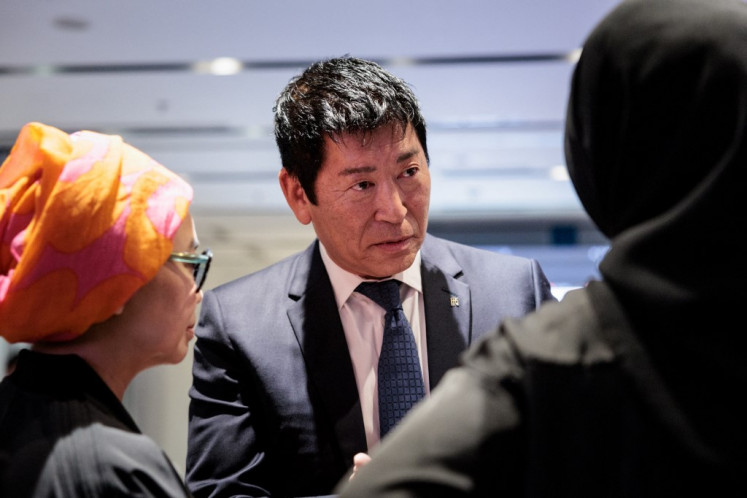Popular Reads
Top Results
Can't find what you're looking for?
View all search resultsPopular Reads
Top Results
Can't find what you're looking for?
View all search results'Jagawana' from Bogor's forests to Leiden
Courtesy of FFTV/IKJItâs not every day that a local horror film makes its way to an international festival, but thatâs what happened with Jagawana, made by students from the Jakarta Arts Instituteâs (IKJ) film and television faculty
Change text size
Gift Premium Articles
to Anyone
 Courtesy of FFTV/IKJ" border="0" height="341" width="241">Courtesy of FFTV/IKJ
Courtesy of FFTV/IKJ" border="0" height="341" width="241">Courtesy of FFTV/IKJItâs not every day that a local horror film makes its way to an international festival, but thatâs what happened with Jagawana, made by students from the Jakarta Arts Instituteâs (IKJ) film and television faculty.
The film earned a spot at the Leiden International Short Film Experience 2015 (LISFE), held in The Netherlands in May.
âWe were very surprised,â said Bambang Supriadi, an IKJ professor cinematographer, about the selection. Jagawana, a Sanskrit word that translates as ârangerâ, was one of 80 films selected from around 1,000 entries.
While student films were ineligible for the festivalâs main prizes, Jagawana was voted the most interesting film of its category by audience members. âIt let our student film come to the global stage and the audience discussion was more interesting,â said Bambang, who attended the festival along with director Svetlana Dea and editor Teguh Yusniwan.
Set and shot in a protected forest in Mount Pancar near Bogor, West Java, the film mixes genres and bumps contemporary family conflict up against Indonesian mythology and folklore.
Jagawanaâs protagonist is Anjani, a young girl who despite her pluck feels alienated by her new stepmother after her parents divorce.
While seeking solace in the woods, she encounters a mystical masked creature who leads the reluctant girl on a fateful journey.
The filmmakers borrow editing and sound techniques from the horror genre to infuse Jagawana with tension, while the costumes and visual effects play on magical realist motifs. The result is off-putting and compelling: imagine The Blair Witch Project meets Hayao Miyazakiâs Spirited Away.
 Svetlana Dea - Courtesy of FFTV/IKJ
Svetlana Dea - Courtesy of FFTV/IKJ
Svetlana used two bits of local folklore into the script. One was about a man from Sumatra who leaves his wife for a quick trip through the forest and returns five years later. The second was an urban legend about campers on Mount Merapi, Central Java, who wake up to find themselves in a spirit-filled marketplace.
Shooting on location needed a crew of five and about 60 student volunteers working â in the mud - for up to 20 hours a day for the three-day shoot.
The cast also had to be up to the challenge, especially for the lead character.
âWe needed a young girl who could act and who is tough and professional,â Teguh said in an email interview. The girl who was eventually cast, Ocha Raqmiq, has grown up around film thanks to her parentsâ involvement in the industry.
The other main character â a spirit who resembles an old woman - needed to be very tall to accentuate her otherworldliness, so the filmmakers cast a man, Saiful Mahya.
âHe had to act using a mask that had very poor ventilation, barefoot in the muddy forest and had to wear heavy makeup and a wig. He was amazing,â Teguh said.
The film was shot for about Rp 100 million, with 60 million put up by the filmmakers (who also raised money by selling hand-made Jagawana-branded tote bags) and Rp 40 million from IKJ alumni Adi Dwianto, who took on the film for the portfolio of his new production company, Rubu-Rubu.
 Mythology: Jagawana builds on an urban legend of backpackers going to sleep on a mountain and waking in a spirit-filled village.(Courtesy of FFTV/IKJ)
Mythology: Jagawana builds on an urban legend of backpackers going to sleep on a mountain and waking in a spirit-filled village.(Courtesy of FFTV/IKJ)
For Bambang, who helped champion the film and guided the filmmakers, it was as important for young filmmakers to delve into Indonesiaâs diverse mythology as it is for them to address with contemporary issues, such as divorce.
âThere are many ways to interpret and adapt cultural heritage to the modern world â it doesnât always have to be a conflict,â he says.
For those interested in viewing Jegawana, they might have to purchase a plane ticket to China, as the film is slated to be shown at the International Beijing Student Film Festival, according to Svetlana.
Or else they can sign up for classes at Jakartaâs Film and Television Arts Institute, where according to editor Teguh, the film is used to inspire incoming students about the potential of student filmmaking in Indonesia.
Courtesy of FFTV/IKJ It's not every day that a local horror film makes its way to an international festival, but that's what happened with Jagawana, made by students from the Jakarta Arts Institute's (IKJ) film and television faculty. Svetlana Dea - Courtesy of FFTV/IKJ Mythology: Jagawana builds on an urban legend of backpackers going to sleep on a mountain and waking in a spirit-filled village.(Courtesy of FFTV/IKJ) Sinister: An ancestral spirit (foreground) leads Anjani through the forest in Jagawana.(Courtesy of FFTV/IKJ)
The film earned a spot at the Leiden International Short Film Experience 2015 (LISFE), held in The Netherlands in May.
'We were very surprised,' said Bambang Supriadi, an IKJ professor cinematographer, about the selection. Jagawana, a Sanskrit word that translates as 'ranger', was one of 80 films selected from around 1,000 entries.
While student films were ineligible for the festival's main prizes, Jagawana was voted the most interesting film of its category by audience members. 'It let our student film come to the global stage and the audience discussion was more interesting,' said Bambang, who attended the festival along with director Svetlana Dea and editor Teguh Yusniwan.
Set and shot in a protected forest in Mount Pancar near Bogor, West Java, the film mixes genres and bumps contemporary family conflict up against Indonesian mythology and folklore.
Jagawana's protagonist is Anjani, a young girl who despite her pluck feels alienated by her new stepmother after her parents divorce.
While seeking solace in the woods, she encounters a mystical masked creature who leads the reluctant girl on a fateful journey.
The filmmakers borrow editing and sound techniques from the horror genre to infuse Jagawana with tension, while the costumes and visual effects play on magical realist motifs. The result is off-putting and compelling: imagine The Blair Witch Project meets Hayao Miyazaki's Spirited Away.
Svetlana used two bits of local folklore into the script. One was about a man from Sumatra who leaves his wife for a quick trip through the forest and returns five years later. The second was an urban legend about campers on Mount Merapi, Central Java, who wake up to find themselves in a spirit-filled marketplace.
Shooting on location needed a crew of five and about 60 student volunteers working ' in the mud - for up to 20 hours a day for the three-day shoot.
The cast also had to be up to the challenge, especially for the lead character.
'We needed a young girl who could act and who is tough and professional,' Teguh said in an email interview. The girl who was eventually cast, Ocha Raqmiq, has grown up around film thanks to her parents' involvement in the industry.
The other main character ' a spirit who resembles an old woman - needed to be very tall to accentuate her otherworldliness, so the filmmakers cast a man, Saiful Mahya.
'He had to act using a mask that had very poor ventilation, barefoot in the muddy forest and had to wear heavy makeup and a wig. He was amazing,' Teguh said.
The film was shot for about Rp 100 million, with 60 million put up by the filmmakers (who also raised money by selling hand-made Jagawana-branded tote bags) and Rp 40 million from IKJ alumni Adi Dwianto, who took on the film for the portfolio of his new production company, Rubu-Rubu.
For Bambang, who helped champion the film and guided the filmmakers, it was as important for young filmmakers to delve into Indonesia's diverse mythology as it is for them to address with contemporary issues, such as divorce.
'There are many ways to interpret and adapt cultural heritage to the modern world ' it doesn't always have to be a conflict,' he says.
For those interested in viewing Jegawana, they might have to purchase a plane ticket to China, as the film is slated to be shown at the International Beijing Student Film Festival, according to Svetlana.
Or else they can sign up for classes at Jakarta's Film and Television Arts Institute, where according to editor Teguh, the film is used to inspire incoming students about the potential of student filmmaking in Indonesia.
______________________
The writer is an intern at The Jakarta Post.
Your Opinion Matters
Share your experiences, suggestions, and any issues you've encountered on The Jakarta Post. We're here to listen.
Thank You
Thank you for sharing your thoughts. We appreciate your feedback.
Share options
Quickly share this news with your network—keep everyone informed with just a single click!
Gift Premium Articles
to Anyone
Share the best of The Jakarta Post with friends, family, or colleagues. As a subscriber, you can gift 3 to 5 articles each month that anyone can read—no subscription needed!
Continue in the app
Get the best experience—faster access, exclusive features, and a seamless way to stay updated.










